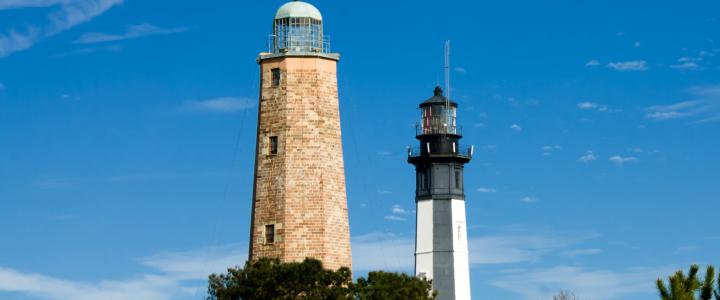
“The rocky ledge runs far into the sea,
And on its outer point, some miles away,
The Lighthouse lifts its massive masonry,
A pillar of fire by night, of cloud by day.
Even at this distance I can see the tides,
Upheaving, break unheard along its base,
A speechless wrath, that rises and subsides
In the white lip and tremor of the face.
And as the evening darkens, lo! how bright,
Through the deep purple of the twilight air,
Beams forth the sudden radiance of its light
With strange, unearthly splendor in the glare!
Not one alone; from each projecting cape
And perilous reef along the ocean's verge,
Starts into life a dim, gigantic shape,
Holding its lantern o'er the restless surge.”
Henry Wadsworth Longfellow, The Lighthouse
When you look at a lighthouse, what do you see? Perhaps to you, lighthouses spark memories of a family vacation to the shore or elicit seafaring imagery that could be ripped from the pages of a Herman Melville novel. Maybe you just see a big flashlight. In the age of electronic navigation and two-way radios, this is understandable. While lighthouses are still utilized in many capes and inlets across the world, they have turned into somewhat of a novelty for many - a relic of days past. But, as is often true with historical structures, these lighthouses hold within them more than steel, brick and glass. Each flame that flickered through the thick windows broke through the panoptic blanket of night and signalled something different to everyone who saw it. Safe passage into harbor. A new beginning. The end of a journey. Home.

Each stair leads to a story and the 191 steps leading to the top of Virginia Beach’s Cape Henry Lighthouse, at the corner of the Chesapeake Bay District and the Oceanfront District, are no exception. This story begins, surprisingly enough, not on the shores where the Chesapeake Bay meets the Atlantic Ocean, but in New York City’s Federal Hall, in 1789. The newly formed United States of America, still recovering from the destruction of revolution, was holding its first session of the First United States Congress, which is still regarded as the most important meeting of the Senate and the House of Representatives ever held. It was at this session that the US Treasury was formed, the rules of the House, Senate and officers were established, and George Washington was inaugurated as the nation’s first President.

It was also during this historic session that Jacob Wray, the collector of customs at Hampton, made a plea to the newly-appointed Secretary of the Treasury, Alexander Hamilton, that the unlit shores of Cape Henry, which had claimed 57 maritime vessels, needed to be promptly addressed. With many Congressional leaders feeling a pressing need to answer the public’s demand for safe and navigable waterways, Hamilton contracted the project with John McComb, Jr., the designer of the planned residence of the President.
Using the Aquia stone that remained on-site from a failed attempt to build a lighthouse during the war, as well as Rappahannock freestone, McCombs plans called for an octagonal structure with three windows in the east and four in the west, that would stand 90 feet above the water table, and cost $17,700, roughly $435,000 in today’s money. As the tower neared completion, President Washington requested a list of applications for the new lighthouse keeper to be selected by him personally. In late October, 1792, Laban Goffigan of Norfolk lit the fish oil-burning lamps of the new Cape Henry Lighthouse for the first time.

The completion of the Cape Henry Lighthouse marked the first federal work project of the new United States government to be fulfilled and it quickly became an important fixture for our region’s maritime enterprises and military. Though a new lighthouse, which is still in use, was built adjacent to it in 1881, the old Cape Henry Lighthouse still stands as a reminder of Virginia Beach’s historic past. Today, you can gain access to the lighthouse, which sits on the active Fort Story Military Base, and climb the winding metal staircase all the way to the top, adding to the revered legend’s story, one step at a time.
Before visiting Cape Henry Lighthouse, be sure to read additional information on location, arrival, and rules and regulations. Please note, visitors without an authorized government ID will be required to board a shuttle to be transported to the historic sites.





